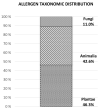Going over Fungal Allergy: Alternaria alternata and Its Allergens
- PMID: 37233293
- PMCID: PMC10219211
- DOI: 10.3390/jof9050582
Going over Fungal Allergy: Alternaria alternata and Its Allergens
Abstract
Fungal allergy is the third most frequent cause of respiratory pathologies and the most related to a poor prognosis of asthma. The genera Alternaria and Cladosporium are the most frequently associated with allergic respiratory diseases, with Alternaria being the one with the highest prevalence of sensitization. Alternaria alternata is an outdoor fungus whose spores disseminate in warm and dry air, reaching peak levels in temperate summers. Alternaria can also be found in damp and insufficiently ventilated houses, causing what is known as sick building syndrome. Thus, exposure to fungal allergens can occur outdoors and indoors. However, not only spores but also fungal fragments contain detectable amounts of allergens and may function as aeroallergenic sources. Allergenic extracts of Alternaria hyphae and spores are still in use for the diagnosis and treatment of allergic diseases but are variable and insufficiently standardised, as they are often a random mixture of allergenic ingredients and casual impurities. Thus, diagnosis of fungal allergy has been difficult, and knowledge about new fungal allergens is stuck. The number of allergens described in Fungi remains almost constant while new allergens are being found in the Plantae and Animalia kingdoms. Given Alt a 1 is not the unique Alternaria allergen eliciting allergy symptoms, component-resolved diagnosis strategies should be applied to diagnose fungal allergy. To date, twelve A. alternata allergens are accepted in the WHO/IUIS Allergen Nomenclature Subcommittee, many of them are enzymes: Alt a 4 (disulfide isomerase), Alt a 6 (enolase), Alt a 8 (mannitol de-hydrogenase), Alt a 10 (aldehyde dehydrogenase), Alt a 13 (glutathione-S-transferase) and Alt a MnSOD (Mn superoxide dismutase), and others have structural and regulatory functions such as Alt a 5 and Alt a 12, Alt a 3, Alt a 7. The function of Alt a 1 and Alt a 9 remains unknown. Other four allergens are included in other medical databases (e.g., Allergome): Alt a NTF2, Alt a TCTP, and Alt a 70 kDa. Despite Alt a 1 being the A. alternata major allergen, other allergens, such as enolase, Alt a 6 or MnSOD, Alt a 14 have been suggested to be included in the diagnosis panel of fungal allergy.
Keywords: Alternaria alternata; fungal allergy; molecular biology.
Conflict of interest statement
The authors declare no conflict of interest.
Figures
Similar articles
-
Alternaria alternata and its allergens: a comprehensive review.Clin Rev Allergy Immunol. 2014 Dec;47(3):354-65. doi: 10.1007/s12016-014-8447-6. Clin Rev Allergy Immunol. 2014. PMID: 25205364 Review.
-
Alternaria alternata allergens: Markers of exposure, phylogeny and risk of fungi-induced respiratory allergy.Environ Int. 2016 Apr-May;89-90:71-80. doi: 10.1016/j.envint.2016.01.003. Epub 2016 Jan 28. Environ Int. 2016. PMID: 26826364 Review.
-
Diagnostic value of Alt a 1, fungal enolase and manganese-dependent superoxide dismutase in the component-resolved diagnosis of allergy to Pleosporaceae.Clin Exp Allergy. 2011 Mar;41(3):443-51. doi: 10.1111/j.1365-2222.2010.03671.x. Epub 2011 Jan 24. Clin Exp Allergy. 2011. PMID: 21255138
-
Characterisation of Alternaria alternata manganese-dependent superoxide dismutase, a cross-reactive allergen homologue to Asp f 6.Immunobiology. 2015 Jul;220(7):851-8. doi: 10.1016/j.imbio.2015.01.006. Epub 2015 Jan 22. Immunobiology. 2015. PMID: 25657116
-
Fungi Sensitization in Spain: Importance of the Alternaria alternata Species and Its Major Allergen Alt a 1 in the Allergenicity.J Fungi (Basel). 2021 Aug 3;7(8):631. doi: 10.3390/jof7080631. J Fungi (Basel). 2021. PMID: 34436170 Free PMC article.
Cited by
-
Dissecting Airborne Allergens.J Clin Med. 2023 Sep 8;12(18):5856. doi: 10.3390/jcm12185856. J Clin Med. 2023. PMID: 37762797 Free PMC article. Review.
-
Effects and health risk assessments of different spray disinfectants on microbial aerosols in chicken houses.Poult Sci. 2025 May;104(5):105083. doi: 10.1016/j.psj.2025.105083. Epub 2025 Mar 21. Poult Sci. 2025. PMID: 40132309 Free PMC article.
-
Characterisation of Alternaria alternata Allergoids: Evaluation of the Stability of Grass Pollen Allergen Extracts Mixed with Alternaria alternata Allergoids.J Fungi (Basel). 2025 Feb 25;11(3):181. doi: 10.3390/jof11030181. J Fungi (Basel). 2025. PMID: 40137219 Free PMC article.
-
Airborne Alternaria Spores: 70 Annual Records in Northwestern Spain.J Fungi (Basel). 2024 Sep 29;10(10):681. doi: 10.3390/jof10100681. J Fungi (Basel). 2024. PMID: 39452633 Free PMC article.
-
Bayesian analysis suggests independent development of sensitization to different fungal allergens.World Allergy Organ J. 2024 May 17;17(5):100908. doi: 10.1016/j.waojou.2024.100908. eCollection 2024 May. World Allergy Organ J. 2024. PMID: 38800499 Free PMC article.
References
-
- Hawksworth D.L. The magnitude of fungal diversity: The 1.5 million species estimate revisited. Mycol. Res. 2001;105:1422–1432. doi: 10.1017/S0953756201004725. - DOI
Publication types
LinkOut - more resources
Full Text Sources


